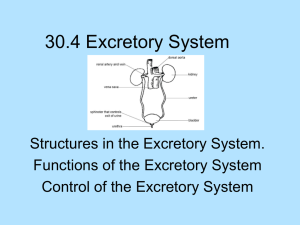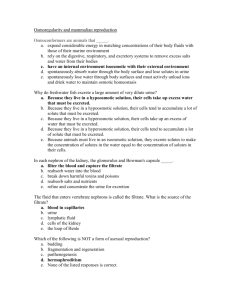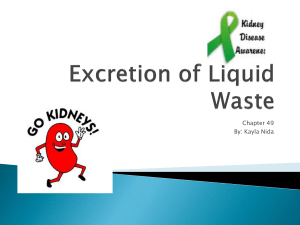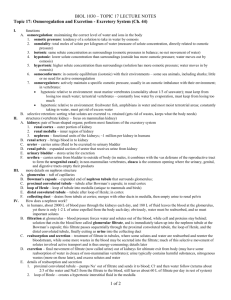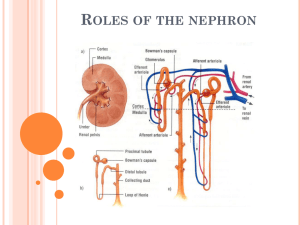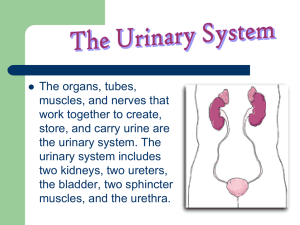chapt51_lecture_ppt
advertisement
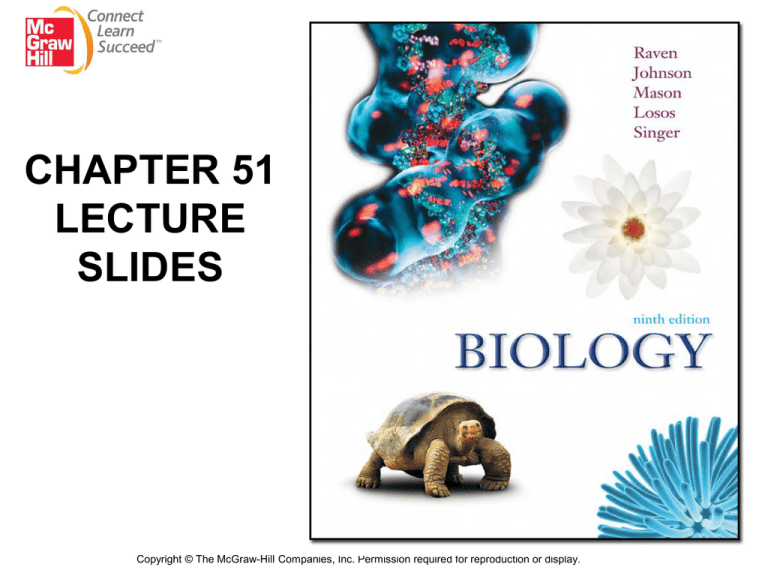
CHAPTER 51 LECTURE SLIDES Copyright © The McGraw-Hill Companies, Inc. Permission required for reproduction or display. Osmotic Regulation and the Urinary System Chapter 51 Osmolarity and Osmotic Balance • Water in a multicellular body distributed between – Intracellular compartment – Extracellular compartment • Most vertebrates maintain homeostasis for – Total solute concentration of their extracellular fluids – Concentration of specific inorganic ions 3 Osmolarity and Osmotic Balance • Important ions – Sodium (Na+) is the major cation in extracellular fluids – Chloride (Cl–) is the major anion – Divalent cations, calcium (Ca2+) and magnesium (Mg2+), the monovalent cation K+, as well as other ions, also have important functions and are maintained at constant levels 4 Copyright © The McGraw-Hill Companies, Inc. Permission required for reproduction or display. External environment Animal body H2O (Sweat) Solutes and H2O Solutes and H2O Intracellular compartment Extracellular compartment (including blood) CO2 and H2O O2 CO2 and H2O Solutes and H2O Solutes and H2O O2 Food and H2O Solutes and H2O Urine (excess H2O) Solutes and H2O Waste 5 Osmolarity and Osmotic Balance • Osmotic pressure – Measure of a solution’s tendency to take in water by osmosis • Osmolarity – Number of osmotically active moles of solute per liter of solution • Tonicity – Measure of a solution’s ability to change the volume of a cell by osmosis – Solutions may be hypertonic, hypotonic, or isotonic 6 Osmolarity and Osmotic Balance • Osmoconformers – Organisms that are in osmotic equilibrium with their environment – Among the vertebrates, only the primitive hagfish are strict osmoconformers – Sharks and relatives (cartilaginous fish) are also isotonic • All other vertebrates are osmoregulators – Maintain a relatively constant blood osmolarity despite different concentrations in their environment 7 Osmolarity and Osmotic Balance • Freshwater vertebrates – Hypertonic to their environment – Have adapted to prevent water from entering their bodies, and to actively transport ions back into their bodies • Marine vertebrates – Hypotonic to their environment – Have adapted to retain water by drinking seawater and eliminating the excess ions through kidneys and gills 8 Osmolarity and Osmotic Balance • Terrestrial vertebrates – Higher concentration of water than surrounding air – Tend to lose water by evaporation from skin and lungs – Urinary/osmoregulatory systems have evolved in these vertebrates that help them retain water 9 Osmoregulatory Organs • In many animals, removal of water or salts is coupled with removal of metabolic wastes through the excretory system • A variety of mechanisms have evolved to accomplish this – Single-celled protists and sponges use contractile vacuoles – Other multicellular animals have a system of excretory tubules to expel fluid and wastes 10 Osmoregulatory Organs • Invertebrates – Flatworms • Use protonephridia which branch into bulblike flame cells • Open to the outside of the body, but not to the inside – Earthworms • Use nephridia • Open both to the inside and outside of the body 11 12 13 Osmoregulatory Organs • Insects – Use Malpighian tubules • Extensions of the digestive tract – Waste molecules and K+ are secreted into tubules by active transport – Create an osmotic gradient that draws water into the tubules by osmosis – Most of the water and K+ is then reabsorbed into the open circulatory system through hindgut epithelium 14 15 Osmoregulatory Organs • Vertebrate kidneys – Create a tubular fluid by filtering the blood under pressure through the glomerulus – Filtrate contains many small molecules, in addition to water and waste products – Most of these molecules and water are reabsorbed into the blood • Selective reabsorption provides great flexibility – Waste products are eliminated from the body in the form of urine 16 Evolution of the Vertebrate Kidney • Made up of thousands of repeating units – nephrons • Although the same basic design has been retained in all vertebrate kidneys, a few modifications have occurred • All vertebrates can produce a urine that is isotonic or hypotonic to blood • Only birds and mammals can make a hypertonic urine 17 18 Evolution of the Vertebrate Kidney • Kidneys are thought to have evolved among the freshwater teleosts, or bony fishes • Body fluids are hypertonic with respect to surrounding water, causing two problems 1. Water enters body from environment • Fishes do not drink water and excrete large amounts of dilute urine 2. Solutes tend to leave the body • Reabsorb ions across nephrons • Actively transport ions across gills into blood 19 Evolution of the Vertebrate Kidney • In contrast, marine bony fishes have body fluids that are hypotonic to seawater • Water tends to leave their bodies by osmosis across their gills • Drink large amounts of seawater • Eliminate ions through gill surfaces and urine • Excrete urine isotonic to body fluids 20 Evolution of the Vertebrate Kidney 21 Evolution of the Vertebrate Kidney • Cartilaginous fish, including sharks and rays, reabsorb urea from the nephron tubules • Maintain a blood urea concentration that is 100 times higher than that of mammals • Makes blood isotonic to surrounding sea • These fishes do not need to drink seawater or remove large amounts of ions from their bodies 22 Evolution of the Vertebrate Kidney • Amphibian kidney is identical to that of freshwater fish • Kidneys of reptiles are very diverse – Marine reptiles drink seawater and excrete an isotonic urine • Eliminate excess salt via salt glands – Terrestrial reptiles reabsorb much of the salt and water in their nephron tubules • Don’t excrete urine, but empty it into cloaca 23 Evolution of the Vertebrate Kidney • Mammals and birds are the only vertebrates that can produce urine that is hypertonic to body fluids • Accomplished by the loop of Henle • Birds have relatively few or no nephrons with long loops, and so cannot produce urine as concentrated as that of mammals • Marine birds excrete excess salt from salt glands near the eyes 24 Evolution of the Vertebrate Kidney 25 Nitrogenous Wastes • When amino acids and nucleic acids are catabolized, they produce nitrogenous wastes that must be eliminated from the body • First step is deamination – Removal of the amino (―NH2) group – Combined with H+ to form ammonia (NH3) in the liver • Toxic to cells, and thus it is only safe in dilute concentrations 26 Nitrogenous Wastes • Bony fishes and amphibian tadpoles eliminate most of the ammonia by diffusion via gills • Elasmobranchs, adult amphibians, and mammals convert ammonia into urea, which is soluble in water • Birds, reptiles, and insects convert ammonia into the water-insoluble uric acid – Costs most energy, but saves most water 27 Nitrogenous Wastes • Mammals also produce uric acid, but from degradation of purines, not amino acids • Most have an enzyme called uricase, which convert uric acid into a more soluble derivative called allantoin • Humans lack this enzyme • Excessive accumulation of uric acid in joints causes gout 28 29 The Mammalian Kidney • Each kidney receives blood from a renal artery • Produces urine from this blood • Urine drains from each kidney through a ureter into a urinary bladder • Urine is passed out of the body through the urethra 30 The Mammalian Kidney • Within the kidney, the mouth of the ureter flares open to form the renal pelvis • Receives urine from the renal tissue • Divided into an outer renal cortex and inner renal medulla 31 The Mammalian Kidney 32 The Mammalian Kidney • The kidney has three basic functions – Filtration • Fluid in the blood is filtered out of the glomerulus into the tubule system – Reabsorption • Selective movement of solutes out of the filtrate back into the blood via peritubular capillaries – Secretion • Movement of substances from the blood into the extracellular fluid, then into the filtrate in the tubular system 33 34 The Mammalian Kidney • Each kidney is made up of about 1 million functioning nephrons – Juxtamedullary nephrons have long loops that dip deeply into the medulla – Cortical nephrons have shorter loops • Blood is carried by an afferent arteriole to the glomerulus • Blood is filtered as it is forced through porous capillary walls 35 The Mammalian Kidney • Blood components that are not filtered drain into an efferent arteriole, which empties into peritubular capillaries – Vasa recta in juxtamedullary nephrons • Glomerular filtrate enters the first region of the nephron tubules – Bowman’s capsule • Goes into the proximal convoluted tubule • Then moves down the medulla and back up into cortex in the loop of Henle 36 The Mammalian Kidney • After leaving the loop, the fluid is delivered to a distal convoluted tubule in the cortex • Drains into a collecting duct • Merges with other collecting ducts to empty its contents, now called urine, into the renal pelvis 37 38 Reabsorption and Secretion • Approximately 2000 L of blood passes through the kidneys each day • 180 L of water leaves the blood and enters the glomerular filtrate • Most of the water and dissolved solutes that enter the glomerular filtrate must be returned to the blood by reabsorption • Water is reabsorbed by the proximal convoluted tubule, descending loop of Henle, and collecting duct 39 Reabsorption and Secretion • Reabsorption of glucose and amino acids is driven by active transport and secondary active transport – Maximum rate of transport – Glucose remains in the urine of untreated diabetes mellitus patients • Secretion of waste products involves transport across capillary membranes and kidney tubules into the filtrate – Penicillin must be administered several times 40 a day Excretion • Major function of the kidney is elimination of a variety of potentially harmful substances that animals eat and drink • In addition, urine contains nitrogenous wastes, and may contain excess K+, H+, and other ions that are removed from blood • Kidneys are critically involved in maintaining acid–base balance of blood 41 Transport in the Nephron • Proximal convoluted tubule – Reabsorbs virtually all nutrient molecules in the filtrate, and two-thirds of the NaCl and water – Because NaCl and water are removed from the filtrate in proportionate amounts, the filtrate that remains in the tubule is still isotonic to the blood plasma 42 Transport in the Nephron • Loop of Henle – Creates a gradient of increasing osmolarity from the cortex to the medulla – Actively transports Na+, and Cl– follows from the ascending loop • Creates an osmotic gradient – Allows reabsorption of water from descending loop and collecting duct – Two limbs of the loop form a countercurrent multiplier system • Creates a hypertonic renal medulla 43 44 Counter Current Multiplier system – Loop of Henle 45 46 Transport in the Nephron • Distal convoluted tubule and collecting duct – Filtrate that enters is hypotonic – Hypertonic interstitial fluid of the renal medulla pulls water out of the collecting duct and into the surrounding blood vessels • Permeability controlled by antidiuretic hormone (ADH) – Kidneys also regulate electrolyte balance in the blood by reabsorption and secretion • K+, H+, and HCO3– 47 48 Hormones Control Osmoregulation • Kidneys maintain relatively constant levels of blood volume, pressure, and osmolarity • Also regulate the plasma K+ and Na+ concentrations and blood pH within narrow limits • These homeostatic functions of kidneys are coordinated primarily by hormones 49 Hormones Control Osmoregulation • Antidiuretic hormone (ADH) – Produced by the hypothalamus and secreted by the posterior pituitary gland – Stimulated by an increase in the osmolarity of blood – Causes walls of distal tubule and collecting ducts to become more permeable to water • Aquaporins – More ADH increases reabsorption of water • Makes a more concentrated urine 50 51 Hormones Control Osmoregulation • Aldosterone – Secreted by the adrenal cortex – Stimulated by low levels of Na+ in the blood – Causes distal convoluted tubule and collecting ducts to reabsorb Na+ – Reabsorption of Cl– and water follows – Low levels of Na+ in the blood are accompanied by a decrease in blood volume • Renin-angiotensin-aldosterone system is activated 52 53 Hormones Control Osmoregulation • Atrial natriuretic hormone (ANH) – Opposes the action of aldosterone in promoting salt and water retention – Secreted by the right atrium of the heart in response to an increased blood volume – Promotes the excretion of salt and water in the urine and lowering blood volume 54
